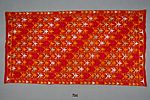phulkari (Shawl)
About this object
History of use
Worn by rural women in Hindu, Sikh and Muslim communities. The origin of this piece is undocumented so we can only speculate on its exact origins. Phulkari shawls have mostly gone out of fashion, with changes in the social structure brought about by Westernization.
Narrative
Penny Gouldstone collected textiles while traveling in Asia with her husband, Brian (the donor). The figures that comprise the design of 1774/4 are highly geometricized, as well as arranged in geometric patterns, which many indicate that it originated in the western part of the region, perhaps Pakistan (phulkari designs from the eastern regions often contain figurative elements). In general, the most common colours used in phulkari work are yellow and white, so the use of hot pink, which is popular in Swat and Hazara, may given some indication of its origin.
Iconographic meaning
The name of the pattern is kanak di bali (ears of wheat) or gulkhehra de phull (hollyhock) da bagh (garden). The border on the ends of the cloth feature the hollyhock motif, whereas the top and bottom borders feature the wheat motif. A narrow second layer in the top and bottom borders feature a flower motif. Phulkari means flower work, and is the name given to a regional embroidery style practiced throughout the Punjab, both in India and in Pakistan, as well as in neighboring regions.
Specific techniques
The stitches may be worked either from the reverse side or the front side, in surface or “false” satin stitch, and the design is visible only from the front. The pattern is formed by counting the threads and picking up a single thread, leaving a long “float” of thread on the front. Also used are the cross stitch and blanket stitch.
Physical description
Woman’s rectangular, embroidered shawl (headcloth). Made of red-orange, coarsely-woven cotton textile, embroidered over-all with brightly coloured, regularly spaced rows of stylized floral shapes that are separated by narrow bands of orange cross-stitch. The floral shapes are identical in shape and alternate in four colours in the row, dark yellow, hot pink, light green and white. They are worked with surface or “false” satin stitch. The alternating colours in the rows match up diagonally across the width of the shawl. Leaf-shaped border designs on the ends and along the sides. The sides are finished with blanket stitch in light green silk, while the ends are unfinished. The piece is constructed of three textile panels which were sewn together before the embroidery was worked.
Date Acquired
10 Nov 1998
How Acquired
Donated
Credit Line
From the Collection of the Late Penny GouldstoneMore...
Measurements
Overall: 133 cm x 256 cm
Object Number
1774/4
